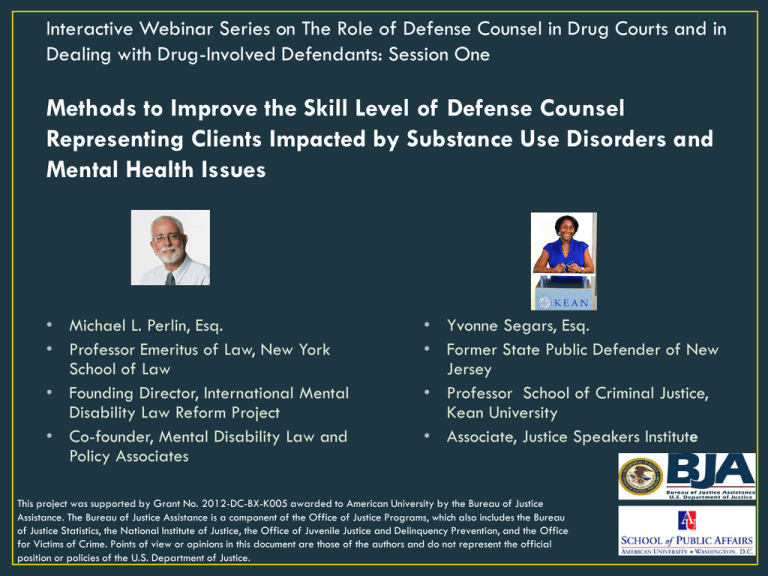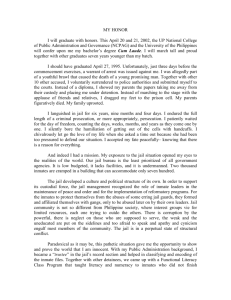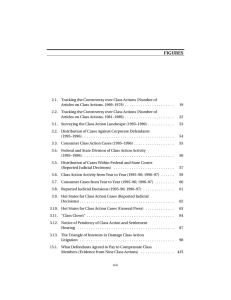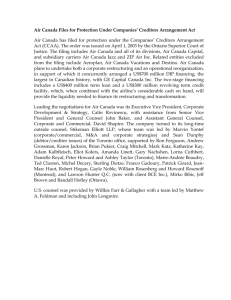Interactive Webinar Series on The Role of Defense Counsel in... Dealing with Drug-Involved Defendants: Session One
advertisement

Interactive Webinar Series on The Role of Defense Counsel in Drug Courts and in Dealing with Drug-Involved Defendants: Session One Methods to Improve the Skill Level of Defense Counsel Representing Clients Impacted by Substance Use Disorders and Mental Health Issues • Michael L. Perlin, Esq. • Professor Emeritus of Law, New York School of Law • Founding Director, International Mental Disability Law Reform Project • Co-founder, Mental Disability Law and Policy Associates • Yvonne Segars, Esq. • Former State Public Defender of New Jersey • Professor School of Criminal Justice, Kean University • Associate, Justice Speakers Institute This project was supported by Grant No. 2012-DC-BX-K005 awarded to American University by the Bureau of Justice Assistance. The Bureau of Justice Assistance is a component of the Office of Justice Programs, which also includes the Bureau of Justice Statistics, the National Institute of Justice, the Office of Juvenile Justice and Delinquency Prevention, and the Office for Victims of Crime. Points of view or opinions in this document are those of the authors and do not represent the official position or policies of the U.S. Department of Justice. Webinar #1: Issues of identifying defendants with mental and cognitive impairments stemming from drug use, pitfalls faced from the start, decision-making variables as to whether or not to seek diversion into problem solving courts Webinar #2: The role of defense counsel in drug courts from initial contact through program completion (including, not limited to, issues of waiver, staffing, medication, pain management, biases [including yours], and situations of noncompliance) Webinar #3: Difficult and challenging cases (including, not limited to, plea variables, likelihood of success in alternative programs, when mitigators are treated as aggravators) Clear to us that one of the greatest set of problems facing public defenders and appointed counsel today is what to do when representing a client with a substance use disorder, who also has, or may have, a mental disorder or disability. Problems arise from the earliest stage starting from the arrest and persist through: Initial interview/intake First appearance/bail hearing Plea/motion practice Decision as to trial/trial strategy During the participation in drug court or other problem solving court Treatment Intensive probation Sanctions/termination Sentence Post-trial To share some insights from our experiences about the difficulties and challenges that lawyers face in representing defendants with drug-related offenses. To highlight and give context to certain data that relates to defendants with drug-related offenses, including the correlation of defendants with substance use disorders and mental health disabilities. To offer practical solutions to ensure more effective representation Rikers/LA County Jail/Cook County Jail have been identified as the nation’s largest mental health facilities But what does that really mean? A rigorous 2009 study by Henry Steadman and his colleagues showed that 14.5% of male inmates and 31% of female inmates had serious mental illness. More recent estimates calculate that 40% of Rikers Island inmates have some sort of mental illness. And consider those in prisons: In 2000, the American Psychiatric Association estimated that 20% of all prisoners were seriously mentally ill. CATEGORY LOCAL JAIL STATE PRISONS mental health problem 64% 56% met criteria for substance 76% dependence or abuse. mental health problem said they had 34% used drugs at the time of the offense 74% nonviolent recidivist with mental health problem 33.2% 32.0% female inmates rates of mental health problems 75% 73% 37% Doris J. James & Lauren E. Glaze, Bureau of Justice Statistics Special Report: Mental Health Problems of Prison & Jail Inmates 4 (2006). * An estimated two-thirds (66 percent) of prisoners and 40 percent of jail inmates with a current chronic condition reported taking prescription medication. What are the implications of this reality? *US Department of Justice, Bureau of Justice Statistics, Medical Problems of State and Federal Prisoners and Jail Inmates, 2011-2012. The clients enter in the court with a substance use disorder. A significant percentage of defense counsel caseload will have some sort of mental disability. A significant percentage of defense counsel caseload will likely benefit from some sort of voluntary mental health treatment. These individuals require specific strategies in the representation process. The statistics previously presented ignore those individuals with intellectual disabilities (formerly identified as “developmentally disabled” or “mentally retarded”) or those on the autism spectrum. The representation of defendants with drug-related offenses who suffer from substance-abuse or a mental or cognitive impairment requires candor, zeal, trustworthiness, knowledge and creativity on the part of the defense lawyer. Representation of these defendants inevitably brings with it ethical dilemmas, process conflicts and the need to understand the dimension of four factors that infect the representational process. Sanism Pretextuality Heuristic reasoning, and False “ordinary common sense” Sanism: An irrational prejudice of the same quality and character of other irrational prejudices that cause (and are reflected in) prevailing social attitudes of racism, sexism, homophobia, and ethnic bigotry. Pretextuality: How courts regularly accept (either implicitly or explicitly) testimonial dishonesty and countenance liberty deprivations in disingenuous ways that bear little or no relationship to case law or to statutes. Heuristics: Cognitive psychology constructs that refers to the implicit thinking devices that individuals use to simplify complex, information-processing tasks, the use of which frequently leads to distorted and systematically erroneous decisions, and causes decision makers to ignore or misuse items of rationally useful information False “ordinary common sense”: A self-referential and nonreflective way of thinking on the part of the lawyer or judge: “I see it that way, therefore everyone sees it that way; I see it that way, therefore that's the way it is.” These four factors dominate the entire representational process and the court process in cases involving criminal defendants with mental disabilities, inside and outside of drug courts and other problem-solving courts. It is essential that lawyers understand their toxicity. How do we identify clients with mental and cognitive impairments, and what are the implications of that identification process ? But, before we start: What myths do we adhere to about both these populations? How do we differentiate clients with “mental illness” from those with “intellectual disabilities”? Why is it absolutely crucial that counsel “gets” these distinctions? As a practical matter, how do these distinctions manifest in treatment court ? Cognitive & Neurological Impairments Difficulty with certain mental tasks such as thinking and understanding, usually with a basis in the biology or physiology of the individual Generally lifelong and will not dissipate For ASD (autism spectrum disorder) and ID (intellectual disability), onset must occur before a specific age Medication cannot restore cognitive ability Assessed by a psychologist or neuropsychologist * Adapted from Eleanore Fritze, Guide to Cognitive and Neurological Disabilities for Lawyers (2015) (unpublished) Mental Illness Disturbances in thought processes, mood, perception or memory. May experience hallucinations and delusions. May be caused by chemical imbalances May be temporary, cyclical or episodic Onset can occur at any stage of life (though onset is typically in teen or early adult years) Medication can be prescribed to control and ameliorate the symptoms Assessed and treated by a psychiatrist Cognitive & Neurological Impairments Difficulty with certain mental tasks such as thinking and understanding, usually with a basis in the biology or physiology of the individual Generally lifelong and will not dissipate For ASD (autism spectrum disorder) and ID (intellectual disability), onset must occur before a specific age Medication cannot restore cognitive ability Assessed by a psychologist or neuropsychologist With education and life-skills training, there can be significant improvement in persons with these impairments (see “right to training” class action litigation). If these individuals have been institutionalized, there is a better-thanaverage chance that they have been improperly medicated. In many communities, there are neither psychologists nor neurologists available to do necessary assessments. Even though the onset may be before a certain age, often there is no “official” determination until after that age. It is essential to keep in mind that an IQ score is not dispositive of a finding of intellectual disability (see Hall v. Florida). Mental Illness Disturbances in thought processes, mood, perception or memory. May experience hallucinations and delusions. May be caused by chemical imbalances May be temporary, cyclical or episodic Onset can occur at any stage of life (though onset is typically in teen or early adult years) Medication can be prescribed to control and ameliorate the symptoms Assessed and treated by a psychiatrist Environmental factors are critical; the home lives of many of our clients can and do exacerbate the underlying biological factors Iatrogenic illness may further exacerbate this condition (hospitalization may worsen mental status) Medication may also have serious and irreversible neurological side effects, especially tardive dyskensia (see e.g., Rennie v. Klein) Many of our clientele have never had access to a psychiatrist We are just learning about the extent of over drugging in foster care and juvenile facilities, and how this may further exacerbate the underlying illnesses. Issues may be of special importance in drug court cases In Court Tardiness Not engaged Anger/Belligerence “Not motivated” Dirty UA’s Thinks the PO is out to get him/her Social Skills (Interactions off balance) Blaming others Disorganized Seemingly irrelevant responses Life skills are lacking In Treatment Not working in group Not attending AA/NA Not completing workbooks Tardiness Inappropriate outburst Extremely sad/mad Sleeping during group Disorganized Social Interactions Need for multiple tracks Need for individualized treatment plans Underlying pressure to move quickly, to use the "crisis" of the arrest to motivate the person to seek treatment and to take a plea ...etc. The judge needs to move this docket or the prosecutor’s plea will evaporate If counsel has 5 minutes with client before first appearance, what cues should and shouldn’t counsel look for, and what questions should and shouldn’t counsel ask? Consider both visual and non-visual cues Consider how the “crisis” of an arrest (a crisis for anyone) has other implications for persons with mental disabilities, and how this may affect the client’s presentation/demeanor The most critical point: insuring that the client develops trust in the lawyer Can you/should you assess whether a defendant appears to be under the influence of drugs or alcohol? If the defendant has been locked up for days/weeks, should that end this inquiry? Can prescribed (antipsychotic) drugs result in the defendant appearing to be under the influence? Start with the worst case scenario: Jurors frequently look for visual cues and clues in determining whether a defendant should be sentenced to death. In this process, they determine-based on their own flawed, pre-reflective “ordinary common sense” whether a defendant looks sufficiently “remorseful.” In a more typical situation: Court observers will make judgments about whether a client looks “high” or “jittery” or “somewhat off.” This is an issue the intake lawyer has to face. Are defense lawyers part of the “public” for these purposes? Just as our insanity defense jurisprudence relies upon “a fixed vision of popular, concrete, visual images of craziness,” so do lawyers representing any defendant with mental illness (or possible mental illness) rely on similar fixed visions. Our reliance on “easy” visual cues can result in both over-inclusion and under-inclusion. If someone “looks crazy,” he/she may not be. Similarly, if someone “looks normal,” that does not mean that he doesn’t suffer from a mental illness Judges are often the most guilty here. Trial judges will typically say, “the defendant doesn't look sick to me,” or, even more revealingly, “he/she is as healthy as you or me.” How does the client present? Is he in appropriately laughing or crying? Is he responsive? Does he/she want to discuss “irrelevant” topics? Caution here: what may be irrelevant to you, his/her criminal defense lawyer, may be very relevant to him/her, and, may be more relevant than the criminal charge (e.g., family matters, housing matters, etc.). If you engage him/her in what should be an anxiety-free conversation, how does he/she respond? If possible, create a baseline—favorite pizza parlor example Consider “body buffer zones” If diversion to a drug or other problem solving court court seems appropriate, is the client competent to make that decision? Can he/she knowingly, intelligently and voluntary waive all rights that might be asserted at a Miranda or Mapp hearing? Is there a question of factual innocence? If client comes from non-”mainstream” cultural background, what other factors do lawyers have to keep in mind? Issues of shame Spirituality/religion Socio-economic disparity Education Issues of physical proximity/”looking in eyes” status Think about specific cultural biases surrounding the issue of mental health care What to do in the case of a client who may have some mental illness, but is not seriously impaired, presents as competent to continue, but might likely be overlooked for drug court or other problem-solving court, but you believe might greatly benefit from it? What are the downsides of raising issues of mental/cognitive impairment(s) and the ability of your client to follow the requirements of the drug court? Will revelation of this sensitive information have a negative impact on the case and your client? How does one get the benefits of diversion for your client without setting them up for failure? Female (32, single mother), full time fast food worker (new job) One prior arrest for DUI; one prior conviction for CDS Left two children home alone (ages 11 & 7) while working Was stopped driving home from work b/c of expired inspection sticker Record check revealed outstanding bench warrant for the DUI Denied knowledge of warrant; she lives at new address During arrest, is found to be in possession of pills without a prescription Arrested for possession of CDS and possession with intent to distribute (60 pills of Oxycontin) and endangering the welfare of her children Children placed in foster care Mary states she is depressed (and was once diagnosed with clinical depression) Intake reveals positive urine screen for opioids During the first two weeks of the program, probation officer indicates that Mary often arrives late for her early morning urine drops Because she is late, that is considered a “positive test”; thus, Mary is now on curfew. Mary has also missed some AA meetings at night Issue: Mary states that she is fine but her behavior is inconsistent: her UA don’t show positive, she says she’s not sad but she is anxious to get her kids back, doesn't need to talk to people, and she doesn't trust the system Problem: The need to determine the source of Mary’s resistance and recognizing that Mary may be steeped in a deep depression. Question: How can you help Mary recognize that she may need clinical help? Male (26, no full time job) Two prior convictions, 1 CDS & 1 theft Is backseat passenger in car (one other passenger in car) stopped at midnight for speeding Car determined to be stolen All three occupants ordered out of the car; search incident to arrest reveals cocaine under front seat, passenger-side Juan denies knowledge of stolen car and CDS possession Police report indicates that Juan is under the influence All three arrested for possession of CDS and receiving stolen property. Juan is offered a deal: post-adjudication drug court as a condition of probation, upon successful completion of the program, conviction to be expunged Question: How would responses be different depending on whether expungement is part of the process? Juan enters post-adjudication drug court Juan is angry most of the time; probation officer claims he is not motivated Juan is not completing his workbooks as required by treatment Juan wants to go to work; program wants him to focus on treatment Juan is diagnosed with bi-polar disorder Issue: Juan doesn’t want to take medication; wants to feel “normal.” Problem: If Juan doesn’t take his medication, the program requires his termination. Question: What would you do? • Bandy X. Lee & Maya Prabhu, A Reflection on the Madness In Prisons, 26 STAN. L. & POL'Y REV. 253, 254 (2015). • Berzofsky, M, & Maruschak, L. M. (2015). Medical Problems of State and Federal Prisoners and Jail Inmates, 2011–12 (Rep. No. NCJ 248491). Retrieved from http://www.bjs.gov/content/pub/pdf/mpsfpji1112.pdf • Critical Issues for Defense Attorneys in Drug Court, National Drug Court Institute (2003) • Doris J. James & Lauren E. Glaze, Bureau of Justice Statistics Special Report: Mental Health Problems of Prison & Jail Inmates 4 (2006). • Eleanore Fritze, Guide to Cognitive and Neurological Disabilities for Lawyers (2015) (unpublished) • Julie D. Cantor, Of Pills and Needles: Involuntarily Medicating the Psychotic Inmate When Execution Looms, 2 IND. HEALTH L. REV. 119 (2005). • Henry Steadman et al, Prevalence of Serious Mental Illness Among Jail Inmates,60 PSYCHIATRIC SERVS. 761 (2009). • Michael L. Perlin, “The Judge, He Cast His Robe Aside”: Mental Health Courts, Dignity and Due Process, 3 MENT. HEALTH L. & POL’Y J. 1 (2013) • Michael L. Perlin, "There Are No Trials Inside the Gates of Eden": Mental Health Courts, the Convention on the Rights of Persons with Disabilities, Dignity, and the Promise of Therapeutic Jurisprudence, in COERCIVE CARE: LAW AND POLICY 193 (Bernadette McSherry & Ian Freckelton, eds. 2013) • Michael L. Perlin, “John Brown Went Off to War”: Considering Veterans’ Courts as Problem-Solving Courts, 37 NOVA L. REV. 445 (2013) • Michael L. Perlin, The Sanist Lives of Jurors in Death Penalty Cases: The Puzzling Role of “Mitigating” Mental Disability Evidence, 8 Notre Dame J.L., Ethics & Pub. Pol'y 239, 265 (1994) . • Michael L. Perlin, “The Borderline Which Separated You From Me”: The Insanity Defense, the Authoritarian Spirit, the Fear of Faking, and the Culture of Punishment, 82 Iowa L. Rev. 1375, 1422 (1997). • Michael L. Perlin, “Infinity Goes up on Trial: Sanism, Pretextuality, and the Representation of Defendants with Mental Disabilities, accessible at http://ssrn.com/abstract=2734762


